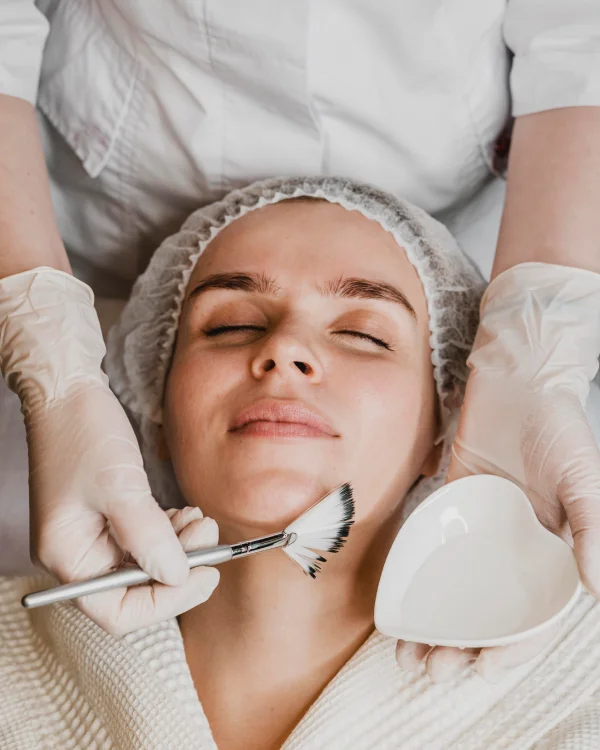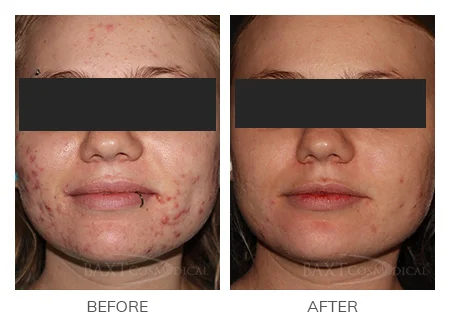Chemical Peel Facial: Best Options for Your Skin Type and What to Expect
A chemical peel facial is no longer a well-kept skincare secret—they’re becoming a popular go-to for clear, radiant skin. Whether you’re dealing with acne scars, uneven tone, or fine lines, a chemical peel might be the customized solution you’re looking for. In this guide, we’ll explore exactly which skin types benefit the most and walk you through what you can expect during the process. If glowing, healthy skin feels out of reach, this could be the treatment to change that.
Stay in Touch
Sign up for our newsletter and get the latest info on specials, deals, promotions and beauty and health tips.
Understanding Chemical Peel Facials
A chemical peel facial is a transformative addition to modern skincare. Designed to rejuvenate the skin, this treatment has gained immense popularity among people looking for smoother, brighter, and healthier-looking skin. Whether you’re combating acne scars, sun damage, or simply aiming to refresh your complexion, chemical peels might just be the skincare solution you never knew you needed.
What are Chemical Peels?
A chemical peel facial is a treatment that uses a chemical solution to remove damaged layers of skin, promoting cell regeneration and uncovering the fresher, smoother skin beneath. Think of it as a reboot for your skin, helping it shed what’s no longer needed and allowing healthier, youthful-looking layers to shine through.
Often performed by dermatologists or licensed estheticians, chemical peels are used to improve various skin issues such as wrinkles, uneven tone, acne scars, and aging signs. The range of chemical peels ensures there’s an option for everyone, from those looking for a light refresh to others needing targeted help with deeper skin concerns. According to the Cleveland Clinic, chemical peels are a safe, effective way to improve your skin’s texture and brightness, provided they’re selected and administered correctly.
How Do Chemical Peels Work?
The science behind a chemical peel facial is surprisingly simple but oh-so-effective. A solution containing exfoliating agents is applied to the face, targeting the outermost layers of skin. These layers consist of dead cells, oil, and other impurities that dull your skin’s glow and contribute to concerns like clogged pores or pigmentation.
Here’s the breakdown:
- Exfoliation: The chemicals in the peel work to dissolve the “glue” that binds dead and damaged skin cells together.
- Cell Turnover: By removing the outer layer, the treatment encourages new cells to form. This process leaves the skin looking smoother, with improved tone and texture.
- Deep Impact: Depending on the type of peel—light, medium, or deep—it can penetrate beyond the surface, targeting deeper issues such as perma-scars or pronounced wrinkles.
The result? A complexion that feels rejuvenated and looks brighter. According to Mayo Clinic, the benefits of chemical peels go beyond aesthetics—they improve skin health by promoting healing and increasing elasticity over time.
Keep in mind, not all peels are created equal. A superficial peel might feel like a day at the spa, while a deep peel is a more intensive process that requires professional supervision and downtime. But no matter the depth, the core principle remains the same: out with the old, in with the new.
Chemical peels aren’t just about aesthetics; they’re about giving your skin the support it needs to stay healthy and resilient. Understanding these processes can help you make informed decisions for your skincare journey.
Types of Chemical Peel Facials and Their Benefits
Chemical peel facials are a versatile skincare treatment designed to address a wide range of skin concerns. From fine lines to acne scars, these treatments vary in intensity and results based on their depth. Understanding the types of peels available can help you determine which one aligns best with your skin goals. Let’s explore the three primary categories of chemical peels and their benefits.
Superficial Peels
For those looking to brighten their skin, superficial peels are an excellent starting point. These mild treatments primarily target the epidermis—the outermost layer of your skin.
Benefits:
- Improves uneven tone: Ideal for addressing minor skin issues like dullness and mild discoloration.
- Quick recovery: With minimal peeling or redness, these peels are perfect for busy schedules.
- Gentle exfoliation: They help remove dead skin cells, leaving your skin smooth and refreshed.
Superficial peels often use ingredients like alpha-hydroxy acids (AHAs) or beta-hydroxy acids (BHAs). They require no downtime, making them a favorite for individuals seeking a quick skin refresh. You can read more about how these peels work in depth on Healthline.

Medium Peels
If superficial peels are a gentle buff, medium peels are a more targeted treatment. They reach deeper into the skin to address moderate issues.
Benefits:
- Reduces fine lines and wrinkles: Great for combatting early signs of aging.
- Evens out skin texture: Helps diminish acne scars and sun spots for a smoother complexion.
- Longer-lasting results: The effects are more noticeable and prolonged compared to superficial peels.
These peels often use trichloroacetic acid (TCA) and require a little downtime, as the skin may peel more noticeably. The payoff? Skin that feels rejuvenated and clearer. For more details, visit the Cleveland Clinic.
Deep Peels
Deep peels are the heavy hitters of the chemical peel facial world. These potent treatments are reserved for severe skin concerns and produce dramatic results.
Benefits:
- Addresses deep wrinkles and scars: Perfect for those with more advanced signs of aging or acne scarring.
- Improves significant pigmentation issues: Effectively tackles stubborn dark spots and hyperpigmentation.
- Transforms skin texture: Leaves your skin looking significantly smoother and more youthful.
Usually performed using phenol or stronger TCA formulations, deep peels require more recovery time but deliver transformative results. These powerful treatments are best suited for individuals willing to dedicate time to healing. Learn more about deep peel effectiveness on StatPearls.
Each type of chemical peel facial holds its unique place in skincare, offering varying levels of exfoliation and rejuvenation. When chosen carefully, they can cater to your specific needs and help you achieve healthier, glowing skin.
Best Chemical Peels for Different Skin Types
Choosing the right chemical peel facial can feel like piecing together a skincare puzzle. Each skin type has unique needs, and the right peel can make all the difference in achieving healthy, rejuvenated skin. Let’s break it down by skin type to help you find your perfect fit.
For Acne-Prone Skin
If breakouts and blackheads are a persistent struggle, salicylic acid peels are your go-to solution. This BHA (beta hydroxy acid) is oil-soluble, allowing it to dive deep into clogged pores and flush out the buildup that causes acne. A salicylic acid peel doesn’t just target pimples—it also tackles blackheads and exfoliates without aggravating inflamed skin.
Mandelic acid peels are another excellent choice for those battling acne, especially if sensitive skin is also a concern. Derived from almonds, mandelic acid is gentle yet effective, helping to reduce inflammation, improve skin texture, and minimize acne scars. Pro tip: Consistency is key with mandelic acid. Regular treatments often yield a smoother and calmer complexion.
According to Orange Coast Dermatology, salicylic acid peels are among the most recommended for acne due to their ability to address both active breakouts and post-acne discoloration.
For Sensitive Skin
For those with easily irritated skin, not all peels are off-limits. Lactic acid peels are an ideal option. Known for being one of the gentlest AHAs (alpha hydroxy acids), lactic acid breaks down dead skin cells without causing redness or irritation. Bonus? It hydrates the skin while it exfoliates, leaving your face refreshed rather than raw.
Mandelic acid peels also work wonders for sensitive skin. They’re low on the irritation scale and pack a punch when it comes to improving texture and evening out tone. These peels are often called “beginner peels” because they’re so gentle—perfect for individuals testing the waters with chemical exfoliation.
For more tips, check out Into the Gloss, which highlights gentle peels that balance effectiveness with skin safety.

For Aging Skin
Fine lines, wrinkles, and sun damage signal the need for more intensive peels. Glycolic acid peels, hailed as a gold standard in anti-aging treatments, penetrate deeper layers of skin to spark collagen production and improve elasticity. This process smooths out wrinkles and leaves the skin looking firmer and brighter.
Jessner’s peels, which blend salicylic acid, lactic acid, and resorcinol, are another effective option for aging skin. They deliver medium-depth exfoliation and target multiple concerns at once, including fine lines, pigmentation, and uneven texture. Trichloroacetic Acid (TCA) peels are another heavy-hitter for more dramatic results, reducing deep wrinkles and regenerating damaged skin layers.
Explore the benefits of TCA and glycolic peels for older skin by visiting AARP.
For Pigmentation Issues
Hyperpigmentation, dark spots, and uneven skin tone require a specialized approach. Glycolic acid peels excel at addressing pigmentation concerns due to their ability to exfoliate and stimulate healthy cell turnover. This not only reduces discoloration but also improves overall skin brightness.
Citric acid peels bring additional radiance, harnessing the natural brightening properties of citrus fruits. These peels are especially effective in fading sunspots and melasma while enhancing your skin’s natural glow.
When tackling pigmentation, patience pays off. Pair peels with diligent sun protection for transformative results. For more on chemical peels and hyperpigmentation, check out CosMedic LaserMD.
Selecting the best chemical peel facial for your skin type takes a personalized touch, but when matched correctly, these treatments can transform your complexion and restore confidence in your skin’s appearance.
What to Expect Before, During, and After a Chemical Peel
Getting a chemical peel facial is a transformative experience for your skin. From preparation to recovery, understanding each stage can help you achieve the best results while reducing any potential discomfort. Here’s everything you need to know to make your journey smooth and effective.
Pre-Peel Preparation
Preparation is key when it comes to chemical peels. Following these steps ensures your skin is ready to maximize the benefits of the treatment:
- Schedule a consultation: Meet with a dermatologist or licensed aesthetician to discuss your skin type, concerns, and goals. This step ensures you choose the right peel for your needs. According to U.S. Dermatology Partners, a professional assessment is crucial to avoid complications.
- Streamline your skincare: Avoid retinoids, exfoliants, and any harsh skincare products at least one week before your treatment. Keeping your routine simple protects your skin from over-sensitivity.
- Hydrate your skin: Drink lots of water and use gentle, hydrating moisturizers leading up to your appointment. Well-hydrated skin responds better to chemical peels.
- Skip sun exposure: Refrain from tanning or prolonged sun exposure a week prior. Sunburned or damaged skin is more susceptible to irritation during the peel.
- Be honest about your medications: Inform your practitioner if you’re on any medication or skincare treatments, as certain prescriptions may increase your skin’s sensitivity.
Preparing your skin properly lays the foundation for optimal results and minimizes side effects.
The Peel Procedure
The idea of a chemical peel facial can feel intimidating, but knowing what to expect during the procedure can ease your worries.
- Cleansing the skin: Before applying the peel, your practitioner will cleanse your face thoroughly to remove oils, dirt, and makeup.
- Application of the solution: The chemical solution will be brushed or swabbed onto your skin. Depending on the depth of the peel, you may feel tingling, itching, or a slight burning sensation. This is normal and lasts only a few minutes.
- Monitoring and timing: Your practitioner will closely monitor your skin to ensure the solution is left on for the right amount of time. Different peels vary in intensity, but the process typically takes 10 to 15 minutes.
- Neutralization (if required): If the peel requires it, the practitioner will apply a neutralizing agent or wash it off to stop the chemical process. Self-neutralizing peels are left on but don’t worry—they’re designed to be safe on the skin.
The peel experience is relatively quick, and professionals like those at Kim Gallo Esthetics emphasize that tailored treatments ensure comfort and effectiveness throughout the process.
Post-Peel Care and Recovery
A chemical peel facial requires attention to aftercare to ensure proper healing and maximize results.
- Immediate aftermath: Expect your skin to feel tight, with potential redness or mild peeling, similar to a sunburn. For deeper peels, swelling may occur and last a few days.
- Moisturize and hydrate: Use a gentle moisturizer several times daily to soothe dryness and irritation. Avoid letting your skin dry out entirely, as this can slow the healing process.
- Hands off!: Resist the urge to pick or peel flaking skin—it’s crucial to let it shed naturally to avoid scarring or uneven healing. The team at Serenity Med Spa notes that patience during this phase is critical.
- Sun protection is non-negotiable: Apply a broad-spectrum sunscreen (SPF 30 or higher) daily to shield your fresh skin from UV damage. Sun exposure can worsen pigmentation issues and undo the benefits of the peel.
- Adjust your skincare: Use only gentle, non-active cleansers and avoid retinoids, exfoliants, and heavy makeup until approved by your practitioner.
- Follow-up matters: Schedule follow-up visits to monitor healing and plan any additional treatments. Deeper peels may require ongoing skincare adjustments to maintain results.
Recovery varies depending on the peel depth. Superficial peels heal within a few days, while medium and deep peels may take up to two weeks. Learn more tips for post-peel care at Mayo Clinic.
By investing time and care into your post-peel routine, you ensure lasting results and a radiant complexion.
Conclusion
A chemical peel facial offers a targeted way to tackle skin concerns like acne, pigmentation, and signs of aging. They work by encouraging cell turnover, unveiling smoother, healthier skin that’s ready to glow.
The key to success lies in choosing the right peel for your unique skin type and needs, guided by the expertise of a skincare professional. A consultation can ensure the safest, most effective results while minimizing risks.
Whether you’re a first-timer or experienced, the benefits of chemical peels are transformative. Ready to unlock clearer, more radiant skin? Schedule a consultation today and let your skincare journey begin!
